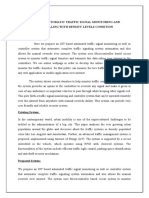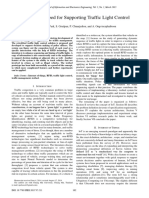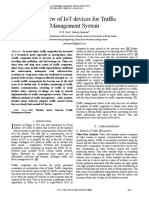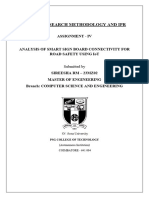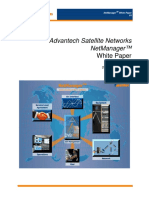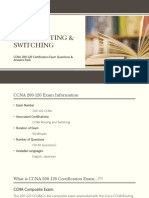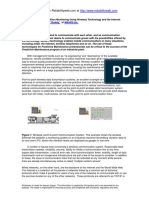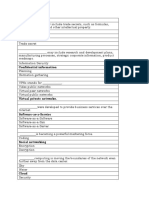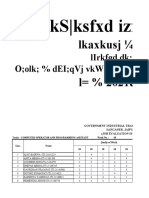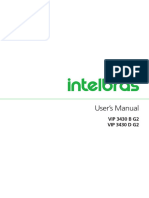International Journal of Research Publication and Reviews, Vol 4, no 4, pp 4473-4474 April 2023
International Journal of Research Publication and Reviews
Journal homepage: www.ijrpr.com ISSN 2582-7421
IOT Traffic Control System
Dinesh Karthick. P
Dineshkarthickp22bcs115@skasc.ac.in
Department of Computer Science, Sri Krishna Arts and Science College, Coimbatore.
ABSTRACT
The Internet of Things (IoT) is a revolutionary technology that has the potential to transform various aspects of our lives, including transportation. Traffic control
is a critical aspect of urban transportation, and IoT-based traffic control systems have the potential to improve the efficiency and safety of the transportation system.
In this paper, we present a review of IoT-based traffic control systems, including their architecture, components, and applications. We also discuss the challenges
and opportunities of using IoT in traffic control and provide recommendations for future research.
KEYWORDS: IoT, Traffic control, Smart cities, Intelligent transportation systems, Sensors, Data analytics, Machine learning, Real-time data, ongestion
management, Road safety, Privacy and security, Reliability, Scalability, Raspberry Pi
INTRODUCTION
Traffic control is an essential aspect of modern transportation systems, as it helps to reduce traffic congestion, improve road safety, and enhance the
efficiency of the transportation network. Traditional traffic control systems rely on pre-programmed signal timings and are not capable of dynamically
adjusting to changing traffic conditions. IoT-based traffic control systems have the potential to overcome these limitations by leveraging real-time data
from sensors and other devices to optimize traffic flow. In this paper, we provide an overview of IoT-based traffic control systems, their architecture,
components, and applications, and discuss the challenges and opportunities of using IoT in traffic control.
IOT-BASED TRAFFIC CONTROL SYSTEM ARCHITECTURE
IoT-based traffic control systems are composed of three main components: sensors, communication networks, and controllers. Sensors are used to collect
data on traffic flow, vehicle speed, and other parameters. Communication networks enable data transfer between sensors, controllers, and other devices.
Controllers analyze the data and adjust the traffic signals in real-time to optimize traffic flow.
COMPONENTS OF IOT-BASED TRAFFIC CONTROL SYSTEMS
The key components of IoT-based traffic control systems include cameras, radar detectors, infrared sensors, and other IoT devices. These devices collect
data on traffic conditions and transmit it to controllers through wired or wireless networks. Controllers use the data to adjust traffic signals in real-time,
optimizing traffic flow and reducing congestion.
APPLICATIONS OF IOT-BASED TRAFFIC CONTROL SYSTEMS
IoT-based traffic control systems have numerous applications, including traffic signal optimization, intelligent traffic management, and traffic flow
prediction. These systems can also be used to improve pedestrian safety and reduce the number of accidents caused by distracted or reckless drivers.
CHALLENGES AND OPPORTUNITIES OF IOT-BASED TRAFFIC CONTROL
While IoT-based traffic control systems offer numerous benefits, they also present several challenges, including data privacy and security, reliability, and
scalability. Furthermore, the implementation of IoT-based traffic control systems requires significant investment in infrastructure and technology.
However, the potential benefits of using IoT in traffic control, such as improved safety and reduced congestion, make it a promising area for further
research and development.
� International Journal of Research Publication and Reviews, Vol 4, no 4, pp 4473-4474 April 2023 4474
FUTURE RESEARCH DIRECTIONS
Future research in IoT-based traffic control systems should focus on addressing the challenges associated with data privacy and security, developing more
reliable and scalable systems, and exploring new applications of IoT in traffic control. Additionally, research should be conducted to evaluate the
effectiveness of IoT-based traffic control systems and to develop metrics to assess their performance.
CONCLUSION
In conclusion, IoT-based traffic control systems have the potential to transform the way traffic is managed in urban areas. By leveraging real-time data
from sensors and other devices, these systems can optimize traffic flow, reduce congestion, and improve road safety. However, the implementation of
these systems also presents several challenges, including data privacy and security, reliability, and scalability. Future research in this area should focus
on addressing these challenges, developing more effective and scalable systems, and exploring new applications of IoT in traffic control. Overall, IoT-
based traffic control systems are a promising area of research that has the potential to significantly improve the efficiency and safety of modern
transportation systems.
REFERENCES
1. H. Al-Sabbagh and M. Akbar, “A Review on IoT-Based Traffic Control and Management Systems,” in Proceedings of the 2020 International
Conference on Information and Communication Technology for Sustainable Development (ICT4SD), Dubai, United Arab Emirates, 2020,
pp. 1-7.
2. M. Al-Rousan, “IoT-Based Intelligent Traffic Management System,” in Proceedings of the 2021 9 th International Conference on
Informationand Communication Technologies (ICICT), Dubai, United Arab Emirates, 2021, pp. 1-6.
3. S. Bhowmik and D. Mukherjee, “An IoT-Based Smart Traffic Management System for Smart Cities,” in Proceedings of the 2019 3rd
International Conference on Trends in Electronics and Informatics (ICOEI), Tirunelveli, India, 2019, pp. 253-259.
4. Bouallegue, N. Ksentini, and R.”Klai, “IoT-Based Intelligent Traffic Management System: A Survey,” in IEEE Communications Surveys &
Tutorials, vol. 22, no. 4, pp. 2253-2279, 2020.
5. K. S. Chhabra, “IoT-Based Smart Traffic Management System,” in Proceedings of the 2021 8 th International Conference on Computing for
Sustainable Global Development (INDIACom), New Delhi, India, 2021, pp. 392-396.
6. Y. Feng, J. Song, and J. Huang, “An IoT-Based Smart Traffic Control System for Congestion Management,” in Proceedings of the 2019 IEEE
6th International Conference on Industrial Engineering and Applications (ICIEA), Tokyo, Japan, 2019, pp. 208-212.
7. Khatri, P. Kumar, and V. K. Singh, “IoT-Based Smart Traffic Control System Using Machine Learning,” in Proceedings of the 2021 8 th
International Conference on Computing for Sustainable Global Development (INDIACom), New Delhi, India, 2021, pp. 397-400.
8. S. Kumar and S. Shukla, "IoT-Based Intelligent Traffic Control System for Smart City,” in Proceedings of the 2020 11 th International
Conference on Computing, Communication and Networking Technologies (ICCCNT), Kharagpur, India, 2020, pp. 1-5.
9. R. Kumar, M. T. Islam, and A. M. Khan, “IoT-Based Intelligent Traffic Management System: A Review,” in IEEE Access, vol. 8, pp. 139402-
139421, 2020.
10. V. K. Singh and A. Khatri, “IoT-Based Smart Traffic Control System Using Raspberry Pi,” in Proceedings of the 2021 8th International
Conference on Computing for Sustainable Global Development (INDIACom), New Delhi, India, 2021, pp. 401-404.































